Olympian Chariot
by Mark Daniels
It's a couple of years since we featured the fantastic Mercette, and as the planetary orbits fall into alignment once again, it's time to blast off for - A Return to Mercury!
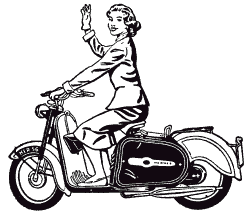
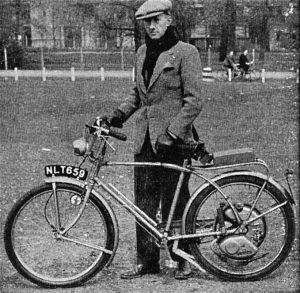
The cyclemotor frame
With this firm you just know it's bound to involve bizarre products from another world, but the story started humbly enough with the establishment of the Mercury Cycle Company at Stratford Road, Birmingham, in 1946. Their rise was meteoric: within a year the business relocated to Dock Lane, Dudley to accommodate increasing demand and rocketing North American exports projected at $1,500,000! By 1948 some 200 employees were already on the payroll; then with the 1950s came the cyclemotor and new opportunities for the first motorised products. These were specially constructed, heavy gauge gents "Diamond" and ladies "Open" style Mercury frames to mount the Cyclemaster unit, made specifically for this pur- pose and supplied with no rear wheel. 1953 listings added a Pillion frame with pad and footrests, and the Roundsman 1cwt rated delivery frame with small front wheel and large carrier. All four products continued up to 1955, when aspirations moved up another gear. The Motor Cycling edition of 10th November 1955 announced that Mercury was entering the lightweight motor cycle market with the Mercette moped (Buzzing Feb 2002), and a 49cc scooter - so we're off in the NACC Time Machine to visit the 1955 Earls Court Motorcycle Show yet again! On this occasion we continue on down the hall towards the Pilbeach Gardens exit. Here between Bond, Douglas, Norman with their famous castle, and Kieft, we find the Mercury pitch number 119, only this time we've returned to look at—The Hermes Scooter!
British scooters sadly lacked the flair of the Latin manufacturers, so it's probably best not to expect too much, in fact I think we'd better pop a couple of antidepressants just in case. There it is—the ugly duckling! Finished in maroon and grey, the show model is majestically mounted on a rotating plinth above a frosted glass dais and cunningly lit from beneath. The presentation may be imaginative but it doesn't actually make the bike any more attractive and one suspects the Italians will be sleeping soundly again tonight. Anyway, on with our mission—press the ‘freeze time’ button on our control unit and whisk the Hermes back to the present day for assessment.
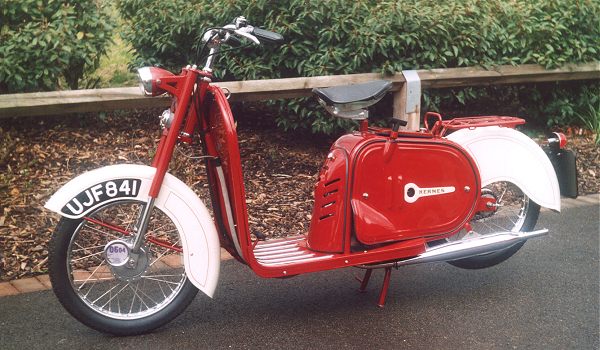
Most striking impression is the sheer length of this thing for such a small capacity machine; the wheelbase is an incredible 50¾ inches with an overall length of 75½ inches! The length becomes even more emphasised by the low height of the bike, the seat is fixed at only 29 inches. Construction of the cycle chassis is practically military grade, with little evidence for economy of materials, and that poor little engine is dragging around 135lbs even before the rider gets on. The scooter styling belies the fact that the Hermes was actually based on an Ilo G50 49cc moped motor: fan-cooled, 2 hand-changed gears, and 2bhp rating.
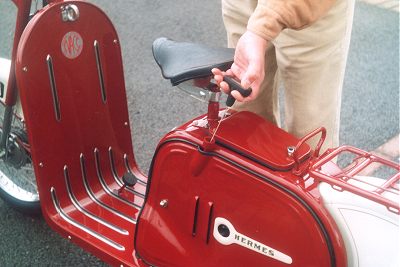
Pull to start!
The pedal facility is blanked out on the motor casings; it’s well before electric-start technology, and there's no kick-start. That leaves just two ways to get it going, you can either bump it down the road, or … there’s a recoil handle underneath the seat! That’s right, you start it like a lawnmower! Petrol tap turns on through a port in the left hand side-panel, and pushing a sprung knob on the front engine panel would remotely close the choke on the original Pallas 14mm carb. Being very careful not to snatch at that infamous recoil, this Hermes starts really easily, then allow the engine to run warm before opening the throttle to release the choke. Nudge it off the stand, clutch is very nice and light, then smoothly into gear with a completely silent shift (Puch, NSU and Villiers could have learned a bit here). The exhaust note is unexpectedly tinny, and graduates into a resonant buzzing as you twist on the throttle to pull away. At this point one would expect to tuck ones feet onto the footboards - except that you can't, since the space is too short to actually get a pair of size 9s in! The bike seems to have been designed for dainty ballerinas, and the foot space simply won’t accommodate a normal sized rider, who can only assume a sort of Quasimodo riding position.
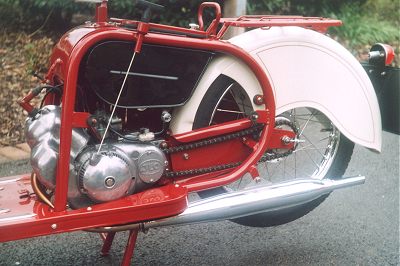
The engine showing the recoil starter mechanism
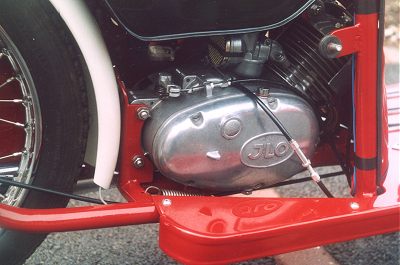
Offside view of the engine
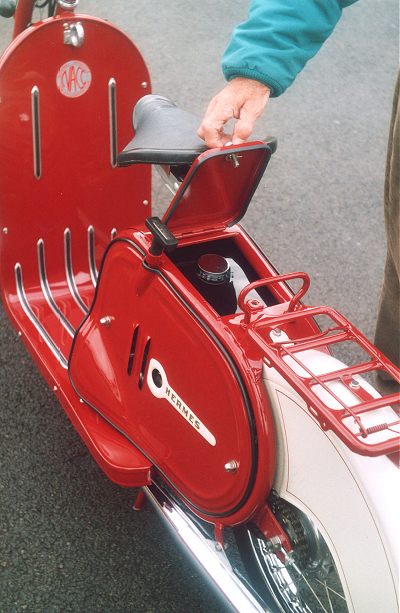
Lift the lid for the filler cap
The little motor is very revvy if you're brave enough to wind it up, though you have to be, or you'll be finding yourself in the category of a traffic hazard! Bottom gear feels very low, but will actually get up to a howling 20mph, and permit you to slowly climb pretty much any hill you come across. Second gear (top) allows a maximum of 33 to 34mph and manages moderate inclines by charging tactics, provided it can be held in the power band, though the low 6.5:1 compression ratio doesn't exactly help much here. If you manage to stall the engine, you then discover that the starting handle described as ‘conveniently positioned behind the saddle’, is practically impossible to operate while you’re sitting on the bike! You really need to get off to restart it, and then find other motorists imparting their opinions regarding the delay this causes. The long wheelbase feels as if it may be inducing a little wander at low speed, but typically becomes more stable as the pace picks up. The 20"×2" Avon tyres on 15" Dunlop rims are a very sure-footed combination for a small capacity machine, and the elegant, finned alloy 4" hubs demonstrate impressively effective braking. The polished alloy brake plates may carry ‘Mercury Industries’ logos, but have definitely been made for them by Grimeca in Italy.
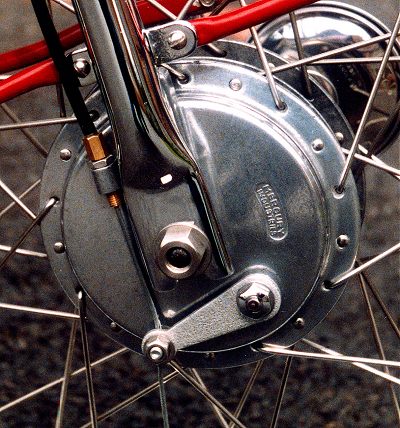
The "Mercury Industries" front hub, made by Grimeca in Italy
The Hermes is a surprisingly stable bike to ride, but somewhat handicapped by the power deficiency and cramped seating arrangement. Despite being competitively priced in the scooter sector, its appeal would have been quite limited, and gives the impression it was probably aimed toward the ladies’ market. Returning from our ride and parking back on the centre stand becomes another puzzle? You can’t access the stand on the left side of the machine but have to be on the right of the bike to toe the tag with your foot, then hauling the contraption back onto its stand by a handle behind the seat proves quite a clumsy operation. It may be conventional for the right-hand drive continent, but is very awkward for the UK market. You'd think Mercury would have just put the tag on the left. A Noris 18W flywheel generator feeds the 15W front and 3W rear Miller lamps providing typical candlepower illumination of the period.
The Hermes was a licence built version of the Meister Solo Roller and appears to have incorporated some of the West German company's components, like the main body panel pressings. Beyond the obviously factored parts, Mercury clearly built up a fair proportion of the machine themselves, since items like the frame and legshield apron carry all the hallmarks of their ‘craftsmanship’. The original Meister fork design subsequently appears to have become adopted for all Mercury and most Dunkley models, though the troublesome hand-starter on the German ILO motor resulted in so many warranty claims that it prompted Mercury to issue a £20,000 claim against ILO for continual failure of the mechanism. Hermes frame series records 100 to 1201 and, though the model was listed up to September 1957, the registration of chassis number 1164 in October 1956 strongly suggests that Mercury had actually built out all the machines by the end of summer 1956. Considering the factored elements, they would have naturally wished to get all the bikes out into the market place and sold as fast as possible to recoup their investment. The bizarre Hermes was succeeded by the equally monstrous Dolphin scooter with 99cc Villiers 4F motor, announced in November 1956 and listed from March 1957. The styling of both models proved of little appeal and late registration records indicate machines still remaining unsold at the dealers several years later. The Pippin Scooter was the final epitaph, styled like a bad Sci-Fi B-movie; few found their way out of the factory before the company's collapse in March 1958. The fall to Earth was as dramatic as the ascendancy; Mercury Industries crashed and burned with huge debts.
As with other Mercury models, the mortality rate has been painfully high. Hopeless frailty of the unique recoil mechanism condemned most machines long before they could be worn out. Fifty years on, and only seven complete Hermes are identified as surviving. Surely listed in the book of History’s Great Heroic Failures, the Hermes was a classic example of right idea but wrong time. Today, the 50cc scooter rules the world!
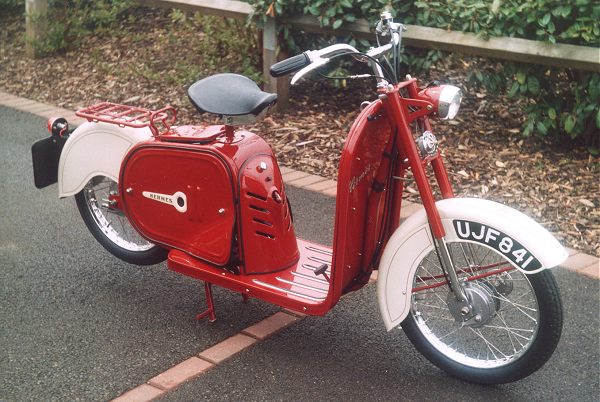
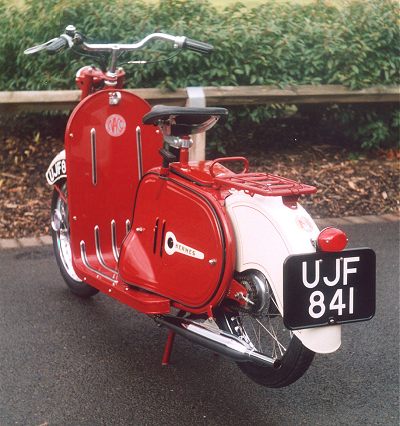
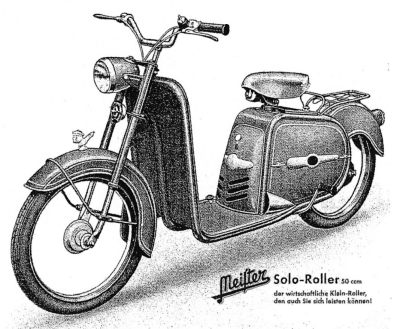
The original Meister scooterette
Next, and we return to a proper bike again—with pedals! The Great War has just ended, and two motoring dynasties merge to produce a famous motor cycle ‘built like a bridge’. Recruiting staff to manufacture a new autocycle, our next adventure starts as we join the company in 1939.
